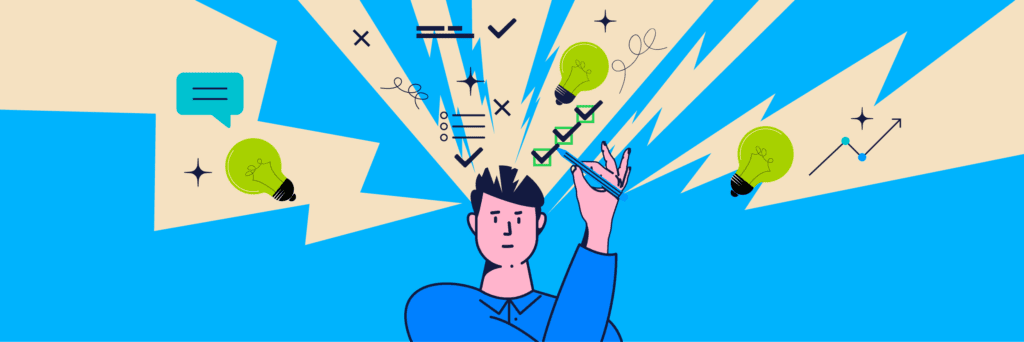Using Design Thinking to Solve Business Problems

I’m Alex Fogg, working on the product User Experience Design team at Inkling. As designers, we’re continually given problems and are told, “good luck!” with solving them. Big problems + no constraints can be daunting – how in the world are we supposed to dive into something so big? How do we even start thinking about it?
User Experience (UX) at Inkling is, at its core, all about empathy and understanding the people who use our tools. Learning about the user is why this team at Inkling exists; it’s in the name, after all. We research our problems by talking to our users to understand their issues better. We design new tools and test them with our users before we launch them to get their thoughts and feelings on them. If our users can’t use the stuff we make or don’t need it, then what’s the point?
We’re used to visual problems and solutions. The thing about UX as a field is that it’s primarily thought of as being visual – the problems we’re solving will often end up being the intuitive user interfaces (the UI) you interact with on the computer or your phone. That’s why this past fall, when we were asked to lead a cross-functional team of Inkling employees to tackle a problem that you can’t necessarily interact with – the problem of how to keep Inkling as a place where employees are thrilled to be – it felt a little intimidating. Anything a little more nebulous wasn’t in our wheelhouse.
As designers, we have all kinds of methods that we can use to help our team break down big problems. One valuable method is called the Design Thinking process. It’s a tried and true method to help anyone – not just designers – solve problems.
At a high level, it consists of 5 steps: Empathize with the users, Define the problem, Ideate, Prototype, and Test. The thought process behind the first two is relatively simple. The more we empathize with the people who have the problem, the easier it is for us to devise a solution that fits. The more we work to define the actual challenge, the quicker we can get to the correct resolution.
All our fears about approaching the problem were resolved when we realized we could apply the standard Design Thinking methodology to this project. It opened our eyes to the idea that we could use Design Thinking with almost any problem.
So here’s how we did it at a high level:
Empathize with Users:
We spent weeks interviewing our fellow employees, sent out multiple surveys, and gathered data on what our competitors do to keep their employees happy. We analyzed all this data and organized it so we could begin seeing patterns emerge.
Define the Problem:
The team took the initial “ask” and determined whether this was the problem we needed to solve. The original “ask” was wide-ranging and had several specific topics involved. During the Define phase, we discussed and determined that a few of these “problems” weren’t problems for our company at all – but there were other fundamental problems that we had discovered during the Empathy phase. We then adjusted and defined the genuine issues. This crucial phase helped our team steer the rest of the project.
Ideate Solutions:
After being knee-deep in data for a month, we finally started brainstorming solutions. In every meeting we had, we had different exercises to get our ideas down. We spent a few weeks discussing and thinking independently about improving the culture here.
Prototype Solutions:
In a design-centered Design Thinking process, this is where we would create a “mock-up.” Since this problem was not visually centered, our “mock-ups” were our recommendations. So, we took the ideas that best addressed our employees’ needs, started listing them, and wrote down action plans.
Test Solutions:
Once we had solid prototypes (or recommendations) that covered everything our employees needed and wanted, we got feedback from a sample group of employees. We took their feedback, made edits, and then tested again. We repeated this cycle until we felt it was ready to share with the company. Also, we cross-checked it against the competitive data we had gathered.
In the end, we had a broad list of recommendations, which had been thoroughly vetted by employees and cross-checked with outside data. We felt confident in our work and had the data to back it up. Ultimately, we got positive reviews from the company at-large about our recommendations. At this time (just two months after we presented it), we’ve already seen some changes based on what we recommended. My cross-functional team, who hadn’t used the Design Thinking process before, told me they had a good experience with it – they felt like it helped us stay focused and move along. We never got stuck in one phase for too long because we knew we could test our findings and revise. Now I know it’s useful for more than just typical “design” projects. It’s suitable for all projects, from instructional design to process re-engineering.
There are numerous other methods you can use when tackling a problem, including;
- The Double Diamond (zoom out and zoom in twice while looking at the problem)
- The Hook Model (great for designing solutions that are habit-forming)
- Lean (good for when you don’t have a lot of time)
but I keep coming back to Design Thinking.
Read more about Design Thinking and other methods here:
